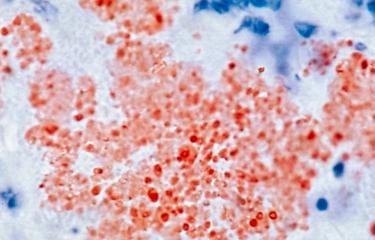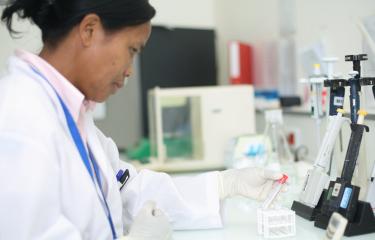Could multidrug resistance become widespread among strains of the plague bacillus? The study of a fragment of mobile DNA conferring to Yersinia pestis resistance against numerous antibiotics has shown that similar elements are present in bacteria found in food products in recent years in the United States, raising fears among researchers from the Institut Pasteur and The Institute for Genomic Research (TIGR, USA). Their work is being published in 'PLoS ONE'.
Press release
Paris, march 20, 2007
the multidrug resistance of the plague bacillus could spread...
The ability to resist multiple antibiotics used against plague has to date only been observed in a single strain that was isolated from a patient in Madagascar in 1995. The researchers from the Institut Pasteur who characterised this strain stressed at that time that "These results are even more alarming since this multidrug resistance has emerged in one of the bacterial species that is most pathogenic for humans, and since the chances of the patient’s survival are directly linked to the rapidity of the antibiotic treatment" (1).
Today it is known that the genes conferring to the Malagasy Y. pestis strain this multidrug resistance (MDR) are carried by a plasmid, a circular DNA molecule that is easily transmitted from one bacterium to another. The sequencing of this plasmid and its comparison with those of other bacteria have just been performed as part of an international study conducted by Jacques Ravel’s laboratory at TIGR in Rockville, Maryland (USA), the Yersinia unit at the Institut Pasteur overseen by Elisabeth Carniel, and two American teams working in the area of agriculture and food products (at the US Department of Agriculture and the US Food and Drug Administration) (2).
In this study, an MDR plasmid very similar to that of Y. pestis has been identified in Salmonella, a food bacterium, whose resistance to a growing number of antibiotics has increased exponentially in recent years. MDR strains of this bacterium and of E. coli have been found in beef-, pork-, chicken-, and turkey-based retail products from various US states. This same resistance plasmid has also been found in other bacteria, in particular those isolated from livestock. The risk that this multidrug resistance is transmitted to other strains of Y. pestis and also to other pathogenic bacteria is therefore real.
"When we identified the first multidrug-resistant strain of Y. pestis, we raised the alert: if this type of strain was to spread or if new multi-resistant strains emerge, it could pose a serious public health problem" Elisabeth Carniel stated. "The discovery that this multi-resistant plasmid acquired by the plague bacillus is widespread in environmental bacteria reinforces our fears."
According to Jacques Ravel: "The fact that we found a plasmid usually found in Salmonella in Y. pestis is a big problem" " Obviously, this is an event that might have serious human health consequences. But the sequencing work we’ve done has given us a way to monitor this plasmid in future "He urges a new monitoring programme to track MDR in Y. pestis".
Plague epidemics have occurred throughout human history, causing the death of around 200 million human beings. Today, the plague is considered as a re-emerging disease, regularly causing small epidemics in different regions of the world. There is no reliable and effective vaccine, and for this reason, antibiotics represent the sole means of treating the disease and limiting the number of human cases. "Our results imply that high-levelresistance to multiple antibiotics could quickly and naturally occur in the plague bacillus,and this would represent a majormedical, public health, and biodefence threat ", the researchers concluded. "The monitoring of multi-resistance should be expanded, especially to the regions of the world where Y. pestis is endemic, including Asia, Africa, and the southern United States, where strains of Y. pestis and MDR strains of Salmonella co-exist,with a high probability of being into direct contact."
Sources
Multiple antibiotic resistance in Yersinia pestis mediated by a transferable plasmid". M Galimand et al. - New England Journal of Medicine, 4 september 1997
Multiple antimicrobial resistance in plague : an emerging public health risk" : PLoS One, mars 2007
Timothy J. Welch (1), W. Florian Fricke (2), Patrick F. McDermott (3), David G. White (3), Marie-Laure Rosso (4), David A. Rasko (2,5), Mark K. Mammel (6), Mark Eppinger (2), MJ Rosovitz (2), David Wagner (7), Lila Rahalison (8), J. Eugene LeClerc (6), Jeffrey M. Hinshaw (9), Luther E. Lindler (10), Thomas A. Cebula (6), Elisabeth Carniel (4) et Jacques Ravel (2)
1. National Center for Cool and Cold Water Aquaculture, Agricultural Research Service, USDA, Kearneysville, WV, USA; 2. The Institute for Genomic Research, Rockville, MD, USA; 3. Office of Research, CMV-FDA, Laurel, MD, USA; 4. Institut Pasteur, Yersinia research unit, Paris, France; 5. University of Texas Southwestern Medical Center at Dallas, TX, USA ; 6. Office of Applied Research and Safety Assessment, CFSAN-FDA, Laurel, MD, USA; 7. Northern Arizona University, Flagstaff, AZ, USA; 8. Institut Pasteur, Antananarivo, Madagascar; 9. Department of Zoology, North Carolina State University, Fletcher, NC, USA; 10. Public Health Laboratory Services, DoD-GEIS, Silver Spring, MD, USA.
Contact persons
Press Office, Institut Pasteur
Nadine Peyrolo or Corinne Jamma
+33 (0)1 40 61 33 41
cjamma@pasteur.fr
TIGR
Jacques Ravel, The Institute for Genomic Research
00 1 301-795-7884
jravel@tigr.org







